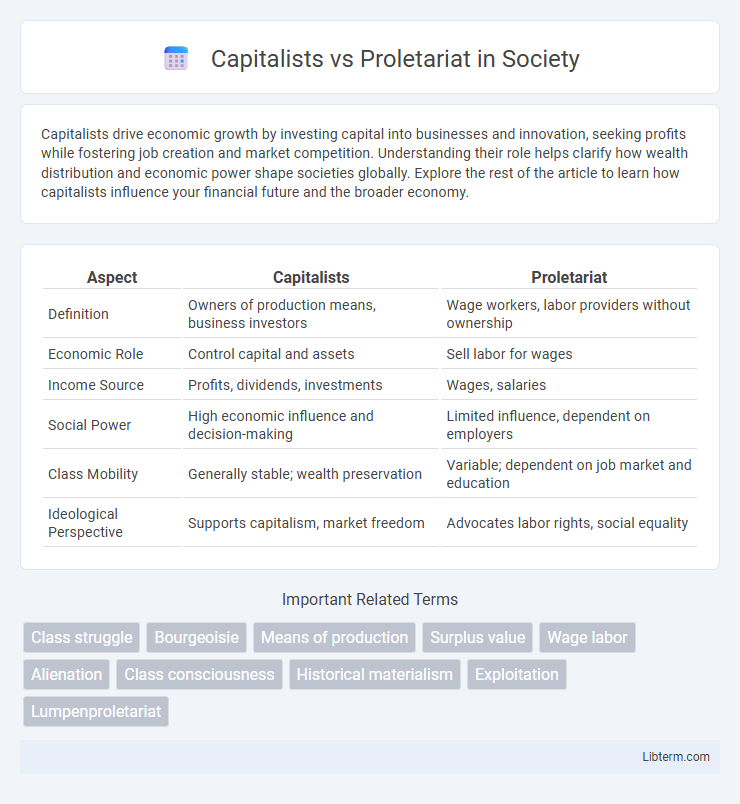Capitalists drive economic growth by investing capital into businesses and innovation, seeking profits while fostering job creation and market competition. Understanding their role helps clarify how wealth distribution and economic power shape societies globally. Explore the rest of the article to learn how capitalists influence your financial future and the broader economy.
Table of Comparison
| Aspect | Capitalists | Proletariat |
|---|---|---|
| Definition | Owners of production means, business investors | Wage workers, labor providers without ownership |
| Economic Role | Control capital and assets | Sell labor for wages |
| Income Source | Profits, dividends, investments | Wages, salaries |
| Social Power | High economic influence and decision-making | Limited influence, dependent on employers |
| Class Mobility | Generally stable; wealth preservation | Variable; dependent on job market and education |
| Ideological Perspective | Supports capitalism, market freedom | Advocates labor rights, social equality |
Understanding Capitalism: Key Concepts
Capitalism centers on private ownership of production means and profit-driven markets, highlighting the divide between capitalists who own capital and proletariat workers who sell labor. Wage labor under capitalism often creates class tensions, as capitalists seek to maximize profits while proletariat demand fair wages and working conditions. Key concepts include surplus value, exploitation, and market competition, which drive economic dynamics and social relations within capitalist societies.
Who Are the Capitalists?
Capitalists are individuals or entities that own and control the means of production, such as factories, machinery, and capital assets, enabling them to generate profits through investment and ownership. They accumulate wealth by employing wage labor from the proletariat, who sell their labor power but do not own production resources. This class distinction underpins economic systems like capitalism, where capitalists hold significant influence over market dynamics and labor relations.
Defining the Proletariat Class
The proletariat class consists of wage laborers who do not own the means of production and must sell their labor power to survive. This social group is defined by its lack of capital, resulting in economic dependency and limited control over work conditions. Marxist theory emphasizes the proletariat's role in the class struggle against capitalists who own factories, land, and resources.
Historical Roots of Class Struggle
The historical roots of the capitalists versus proletariat class struggle trace back to the Industrial Revolution, where the rise of factories shifted economic power to owners of capital, creating a clear divide between wage laborers and capital holders. This shift disrupted traditional feudal systems, leading to heightened exploitation and social inequality as workers sold their labor under conditions controlled by capitalists. The resulting tensions fueled key Marxist theories on class conflict, emphasizing the economic and social antagonism between the bourgeoisie and the working class throughout modern industrial societies.
The Role of Wealth and Ownership
Capitalists hold wealth through ownership of production means, directly controlling resources and capital assets that generate profit. Proletariat, lacking ownership, rely on selling labor power in exchange for wages, facing limited economic power and wealth accumulation opportunities. This ownership disparity creates inherent class conflict, influencing social dynamics and economic inequality.
Power Dynamics in the Workplace
Capitalists hold significant control over the means of production, leveraging economic power to dictate workplace conditions and labor policies. Proletariat workers often face limited bargaining power, resulting in disparities in wages, job security, and decision-making influence. This power imbalance reinforces systemic inequalities, shaping workplace hierarchies and impacting overall labor relations.
Impact on Wages and Living Conditions
Capitalists often set wages based on maximizing profit, which can suppress workers' earnings and limit improvements in living conditions for the proletariat. The proletariat, relying on wage labor, frequently faces economic insecurity and struggles to achieve stable housing, healthcare, and education. These disparities highlight the systemic tension between capital accumulation and the socioeconomic well-being of the working class.
Class Conflict in Modern Economy
Class conflict in the modern economy centers on the tension between capitalists, who own productive assets and accumulate wealth, and the proletariat, who sell labor for wages. This ongoing struggle drives income inequality and social unrest, as capitalists seek profit maximization while workers demand fair wages and improved working conditions. Understanding these dynamics is crucial for addressing economic disparities and fostering equitable growth.
Key Theorists: Marx and Beyond
Karl Marx's analysis of the conflict between capitalists and proletariat centers on class struggle as the driving force of historical change, emphasizing exploitation under capitalism. Beyond Marx, theorists like Antonio Gramsci expanded on cultural hegemony to explain how capitalist dominance is maintained through ideological control. Contemporary scholars build on these foundations, examining class dynamics within global capitalism and the impact of neoliberal policies on labor relations.
Future Perspectives: Bridging the Divide
Future perspectives on bridging the divide between capitalists and the proletariat emphasize inclusive economic policies that promote wealth redistribution and equitable opportunity access. Technological advancements can democratize capital ownership through decentralized finance and cooperative platforms, reshaping traditional capitalist structures. Sustainable development and social innovation create pathways for collaboration, reducing class disparities and fostering economic resilience.
Capitalists Infographic

 libterm.com
libterm.com